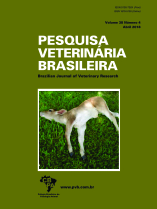 |
|
|
|
Year 2018 - Volume 38, Number 4
|

|
Incidence of Anaplasma marginale, Babesia bigemina and Babesia bovis among calves in the semiarid region of Paraiba, Brazil, 38(4):605-612
|
ABSTRACT.- Costa V.M.M., Ribeiro M.F.B., Duarte G.A.F.P., Soares J.F., Azevedo S.S., Barros A.T.M., Riet-Correa F. & Labruna M.B. 2018. [Incidence of Anaplasma marginale, Babesia bigemina and Babesia bovis among calves in the semiarid region of Paraiba, Brazil.] Incidência de Anaplasma marginale, Babesia bigemina e Babesia bovis em bezerros no semiárido paraibano. Pesquisa Veterinária Brasileira 38(4):605-612. Departamento de Medicina Veterinária Preventiva e Saúde Animal, Universidade de São Paulo, Avenida Prof. Orlando Marques de Paiva 87, São Paulo, SP 05508-270, Brazil. E-mail: labruna@usp.br
This study evaluated the incidence of natural infection by agents of cattle tick fever (CTF), Anaplasma marginale, Babesia bovis and Babesia bigemina in calves born in five farms within the semiarid region of Paraíba state, Brazil. In each farm, blood samples were collected from 6 to 14 calves every 14 days during the first 12 months of life of each animal. Blood samples were processed by microhematocrit and tested by PCR for detection of DNA of A. marginale, B. bovis and B. bigemina. In parallel, the tick infestations on animals were quantified in the five farms, as well as populations in horseflies in three farms. From a total of 41 calves monitored during the first year of life, 25 (61.0%) had positive PCR for A. marginale, 7 (17.1%) for B. bigemina and 3 (7.3%) to B. bovis. Incidence values for A. marginale infection ranged from 83.3% to 100% in four farms. Infection with B. bigemina in calves was detected at only two farms (incidence of 12.5% and 85.7%) and by B. bovis in just one (42.8% incidence). On one farm 14 calves remained negative for A. marginale, B. bigemina and B. bovis during the 12 month follow-up. PCR results were confirmed by DNA sequencing of amplified products. The presence of Rhipicephalus (Boophilus) microplus was found only in two farms in which there was infection by A. marginale, B. bigemina and B. bovis (the latter agent in only one of them). A total of 930 horseflies were captured in the study, most during periods of rain in the region; 70.7% of horseflies corresponded to Tabanus claripennis. There was significant association between a positive PCR for A. marginale and B. bigemina and lower hematocrit values. This study demonstrates that even evaluating only five rural properties, the incidence of CTF occurred heterogeneously in the region, confirming the status of enzootic instability area for CTF, previously reported for the semiarid region of Paraiba.
|
| |
|
|
| |
|
 |